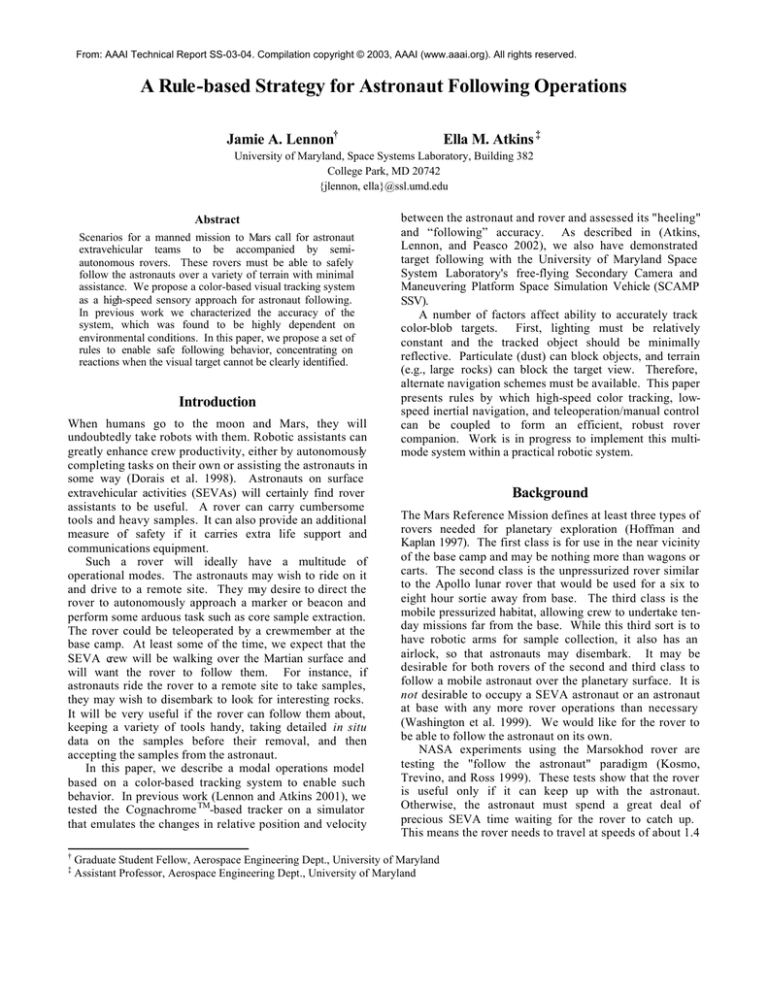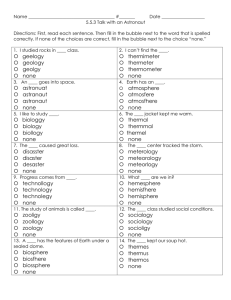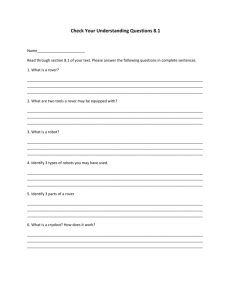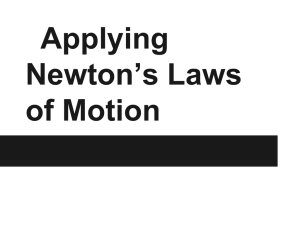
From: AAAI Technical Report SS-03-04. Compilation copyright © 2003, AAAI (www.aaai.org). All rights reserved.
A Rule-based Strategy for Astronaut Following Operations
Jamie A. Lennon†
Ella M. Atkins ‡
University of Maryland, Space Systems Laboratory, Building 382
College Park, MD 20742
{jlennon, ella}@ssl.umd.edu
Abstract
Scenarios for a manned mission to Mars call for astronaut
extravehicular teams to be accompanied by semiautonomous rovers. These rovers must be able to safely
follow the astronauts over a variety of terrain with minimal
assistance. We propose a color-based visual tracking system
as a high-speed sensory approach for astronaut following.
In previous work we characterized the accuracy of the
system, which was found to be highly dependent on
environmental conditions. In this paper, we propose a set of
rules to enable safe following behavior, concentrating on
reactions when the visual target cannot be clearly identified.
Introduction
When humans go to the moon and Mars, they will
undoubtedly take robots with them. Robotic assistants can
greatly enhance crew productivity, either by autonomously
completing tasks on their own or assisting the astronauts in
some way (Dorais et al. 1998). Astronauts on surface
extravehicular activities (SEVAs) will certainly find rover
assistants to be useful. A rover can carry cumbersome
tools and heavy samples. It can also provide an additional
measure of safety if it carries extra life support and
communications equipment.
Such a rover will ideally have a multitude of
operational modes. The astronauts may wish to ride on it
and drive to a remote site. They may desire to direct the
rover to autonomously approach a marker or beacon and
perform some arduous task such as core sample extraction.
The rover could be teleoperated by a crewmember at the
base camp. At least some of the time, we expect that the
SEVA crew will be walking over the Martian surface and
will want the rover to follow them. For instance, if
astronauts ride the rover to a remote site to take samples,
they may wish to disembark to look for interesting rocks.
It will be very useful if the rover can follow them about,
keeping a variety of tools handy, taking detailed in situ
data on the samples before their removal, and then
accepting the samples from the astronaut.
In this paper, we describe a modal operations model
based on a color-based tracking system to enable such
behavior. In previous work (Lennon and Atkins 2001), we
tested the Cognachrome TM-based tracker on a simulator
that emulates the changes in relative position and velocity
†
‡
between the astronaut and rover and assessed its "heeling"
and “following” accuracy. As described in (Atkins,
Lennon, and Peasco 2002), we also have demonstrated
target following with the University of Maryland Space
System Laboratory's free-flying Secondary Camera and
Maneuvering Platform Space Simulation Vehicle (SCAMP
SSV).
A number of factors affect ability to accurately track
color-blob targets. First, lighting must be relatively
constant and the tracked object should be minimally
reflective. Particulate (dust) can block objects, and terrain
(e.g., large rocks) can block the target view. Therefore,
alternate navigation schemes must be available. This paper
presents rules by which high-speed color tracking, lowspeed inertial navigation, and teleoperation/manual control
can be coupled to form an efficient, robust rover
companion. Work is in progress to implement this multimode system within a practical robotic system.
Background
The Mars Reference Mission defines at least three types of
rovers needed for planetary exploration (Hoffman and
Kaplan 1997). The first class is for use in the near vicinity
of the base camp and may be nothing more than wagons or
carts. The second class is the unpressurized rover similar
to the Apollo lunar rover that would be used for a six to
eight hour sortie away from base. The third class is the
mobile pressurized habitat, allowing crew to undertake tenday missions far from the base. While this third sort is to
have robotic arms for sample collection, it also has an
airlock, so that astronauts may disembark. It may be
desirable for both rovers of the second and third class to
follow a mobile astronaut over the planetary surface. It is
not desirable to occupy a SEVA astronaut or an astronaut
at base with any more rover operations than necessary
(Washington et al. 1999). We would like for the rover to
be able to follow the astronaut on its own.
NASA experiments using the Marsokhod rover are
testing the "follow the astronaut" paradigm (Kosmo,
Trevino, and Ross 1999). These tests show that the rover
is useful only if it can keep up with the astronaut.
Otherwise, the astronaut must spend a great deal of
precious SEVA time waiting for the rover to catch up.
This means the rover needs to travel at speeds of about 1.4
Graduate Student Fellow, Aerospace Engineering Dept., University of Maryland
Assistant Professor, Aerospace Engineering Dept., University of Maryland
m/s.
(This is an average walking speed for an
unencumbered human on earth, and it is unlikely that a
suited astronaut will exceed it.) Previous rover research
testbeds combined teleoperation with autonomous
navigation and obstacle avoidance using stereo vision.
Such systems could achieve speeds of around 0.5 m/ s
(Simmons et al. 1995), too slow for following an astronaut
at a "natural" gait.
An astronaut in SEVA is already performing navigation
and some obstacle avoidance as he or she traverses the
Martian terrain. We wish to take advantage of advanced
human perception capabilities to augment rover navigation.
In "following" mode, the rover does not need to perform
extensive analyses of the surrounding terrain if it can rely
on its human partner to pick a safe path. It needs only to
record that path and then follow it while maintaining a safe
distance between itself and the astronaut. How will it
observe and record that path?
Efficient resource utilization – including computing
resources – is one of the essential components of a
successful autonomous system (Washington et al. 1999).
Color blob tracking is a simple and fast vision process. It
has been proven to be fast, accurate, and robust in several
robotics competitions (Bailey et al. 1998) and also does not
require the astronaut to carry any emitters or equipment
other than a small colored target. While a gesture-based
system would allow for more complex communications
between the rover and astronaut, it would also require
either more complicated vision processing or transmission
of astronaut finger joint angles to the rover. Note that
although we assume color blob tracking in the below
discussion, an analogous following strategy would apply
for alternative relative navigation signals subject to loss.
Modal Operations
Color blob tracking is useful in a variety of situations. But
there are many situations where the rover could find
lighting conditions impossible to handle or simply lose
sight of the astronaut. How shall it proceed in these all
too-frequent cases?
A Biological Paradigm
A possible answer lies in examining another multiagent
expeditionary force - the family on vacation. Generally, a
few members (the adults) fulfill the role of the astronaut,
selecting areas of interest and leading the rest of the family
to them.
The children tag along behind, through
complicated fields of mobile obstacles that bear a strong
resemblance to their tracking targets.
To assist their
children in tracking them, many parents provide extra
visual clues - a balloon of a certain color high overhead, or
a distinctive hat worn on a tall adult. But as we all know,
even these augmented color blob tracking methods can fail,
and the child may find himself separated from the adult.
What the child does in this situation depends on how he
has lost track of the adult and where he is at the moment.
If the child cannot see the adult because the adult just
walked behind the corner of a building, the child if sure
that if he also continues around the corner of the building,
he will see the adult again. This loss of signal is far less
troubling than when the child, preoccupied by something
else, looks around to discover that he has lost sight of the
tracked object. He does not know where the adult has
gotten off to, in what direction, or how far away he might
be. If the child feels truly lost, he will engage in a
behavior to aid in becoming found again. The behavior
selected may depend on the environment.
A child in an unknown, potentially hostile environment
has probably been instructed to do one of two things. First,
he can seek out a known safe spot or landmark - a police
officer or a meeting place established in case of separation.
Second, he can stay where he is so his parents can
backtrack and find him. Broadcasting a distress signal is
an option in both cases.
A child in a known or structured environment might
feel comfortable searching for his parents. If separated in,
for instance, a grocery store, a simple pattern search
checking each of the aisles is likely to reveal the location
of the parents. The child can use his knowledge of his
parents' shopping patterns (starting at one end of the store
and going through the aisles, moving slowly in the aisles as
they shop) and his other beliefs (that they could also be in
line at the checkout, that they won't leave without him) to
aid in the search. A simple visual search can again be
augmented by other means, particularly widely
broadcasting a signal of some kind. The child might call
out for his parents as he looks down the aisles, or might
even ask the store owner to use the public address system
to call them.
Applying the Paradigm to the Rover
A rover can be programmed with all of these behaviors.
For this discussion, we presume a rover with camera
mounted on a PTU (pan-tilt unit) is used to perform colorblob tracking. We presume the operator has set the rover
to prefer “following” mode to maximize travel speed and
minimize operator overhead. Figures 1 - 3 show the
schematics for recovering from situations in which color
tracking capabilities are potentially compromised. We
present recovery strategies both for a rover losing signal
while tracking and the case when it disengages from some
other task and cannot find the astronaut/target. In all
figures, encountering a “Follow” block implies high-speed
color blob tracking may again be engaged, while a “Stop”
block implies human intervention potentially in the form of
inertial navigation commands or direct teleoperation is
required.
When the tracked object is lost, the rover should first
consider how it was lost. First, the hardware is checked for
nominal performance. If either camera or Cognachrome TM
is not working, tracking cannot occur. Figures 1 and 2
consider the cases where the target was being tracked when
it was lost. Figure 3 considers the case where the rover
“looks up” from another task and cannot see the astronaut.
Figure 1: Reacquiring signal when target exits edge of screen
Figure 2: Reacquiring signal when target disappears from near-center screen
Figure 3: Reacquiring signal when target disappears while rover is not tracking it
Figure 1 considers those cases where the astronaut has
left the field of view under his own power. These are the
cases when the target is moving left to right, or up to down,
too quickly for the PTU to track (or, if the PTU has reached
a hard stop, for the rover to turn) and goes off-screen. They
can be identified by examining the centroid data prior to
loss of signal (LOS). The last known centroid position can
tell us whether the target was at the edge of the screen. If
the centroid’s velocity is also towards that edge, we may say
that the centroid moved off-screen. If the velocity was in a
different direction or was zero, then the target did not move
of its own accord off-screen, and the LOS is probably the
result of one of the causes found in Figure 2.
For clarity in Figure 1, two separate procedures were
combined in the questions, “Does turning right/left help?”
and “Does following help?” In the case of turning, the PTU
should obviously turn until it reaches a hard stop before
turning the rover. It simply takes less power to move the
PTU than the entire vehicle. For the top/bottom following,
the PTU should first tilt in that direction until a hard stop is
reached, to see if this brings the astronaut back into view. If
that does not, however, the rover should carefully embark
upon the astronaut’s path up to the point of disappearance.
We know that the astronaut cannot fly, so we assume that
any disappearance off of the top of the screen is the result of
the astronaut climbing a terrain feature. As the rover
physically follows, it too will ascend the terrain feature, and
the astronaut should become visible again. The case of the
bottom of the screen must be more cautious, since there may
be holes or rocks into or behind which the astronaut may
fall. The case of falling is distinguished from the case of the
astronaut descending a terrain feature by the rate at which
the aspect ratio of the target changes as it goes off-screen.
We assume that an astronaut falling uncontrollably will
leave the screen much more quickly than one walking over
the crest of a hill. The rate of change in the aspect ratio of
the target as it leaves the screen will then also be greater for
a fall than for walking.
Figure 2 covers those cases where the target does not
leave the screen under its own power. Changes in lighting
and dust accumulation can affect Cognachrome TM
calibration to the point where the target is no longer visible.
A sudden, violent Martian dust storm may obscure all
vision. Or it may be that the astronaut has simply stepped
behind a rock, or has gotten too far away.
Since the area of the target is used to calculate the range
from the rover to the target, the change in area can be used
to compute the linear velocity of the target – assuming the
entire target is visible. If the astronaut were to step behind a
rock, the sudden decrease in target area would indicate that
he was dashing across the landscape at high speeds! We can
use our knowledge of the astronaut’s range of possible
velocities to separate these cases. Of course, the astronaut
may drift behind the rock very slowly. In these cases, we
examine the aspect ratio just before LOS. If the aspect ratio
was very close to 1, then the entire target was on-screen
until LOS, and it is likely that the astronaut has simply
gotten out of camera range. (This can, of course, be
checked with the last known range of the astronaut). If the
aspect ratio were not 1, then the target was occluded before
LOS, and the astronaut has probably stepped behind some
obstacle.
In the cases where the area decreased too suddenly for it
to be the result of astronaut motion, we again turn to the rate
of change in the aspect ratio to distinguish between cases.
A change in aspect ratio conforming to astronaut movement
reinforces the idea that the astronaut has stepped behind
something. A very, very rapid change in aspect ratio could
indicate that a dust storm has blown across the area. What
if the aspect ratio did not change at all, but was constant up
until LOS? The target may have suddenly become backlit
(which is remedied with illumination). A dust storm that
maintained target symmetry until LOS is another possible
culprit.
Figure 3 handles the “child lost in the store” scenarios.
It may be that the SEVA plans called for the rover to engage
in some activities independent of the astronaut. If this is the
case, then everything is going according to plan, and there is
no cause for alarm. But what if the rover expects to see the
astronaut in the area when it has finished its task? The first
step, of course, is to look around for the astronaut. If the
target is not immediately apparently, there is also the
possibility that lighting or dust accumulation has changed
the apparent color of the target. To check, one can paint a
small patch of the target’s color on the rover itself,
somewhere where the PTU can precisely aim the camera at
it and expect back a certain area, centroid, and aspect ratio.
If this on-vehicle target is invisible, the rover can use it to
recalibrate itself. (If the on-vehicle target is entirely
obscured by dust, recalibration will obviously fail and the
astronaut cannot be tracked, even if in the area). Now
certain that its color information is updated to reflect the
most recent environmental conditions, the rover can look
around for the astronaut again. If the astronaut is still not
visible, the rover is lost and waits for directions or
assistance.
Conclusions and Future Work
In this paper, we have presented a rule-based behavior
strategy for robust application of color blob tracking to the
astronaut following problem, emphasizing recovery when
the tracked target is lost. For a Mars rover already equipped
with several different cameras, visual tracking is an
attractive option. The position information gleaned from
the camera(s) can be used in a control system to enable the
rover to follow the astronaut over unknown terrain. In this
way, we take advantage of the astronaut's superior
navigation and planning abilities and free the rover from a
time-consuming analysis of the local terrain and its hazards.
Since the path the astronaut has taken is known to be safe,
the rover can follow at velocities on the order of human
walking speed, allowing it to keep pace with its human
teammate. Should the rover lose sight of the human, either
because of lighting conditions or because of other factors,
mode-switching operations can enable it to determine its
next best course of action.
We have tested basic following capabilities under
“perfect” conditions in which the target can always be
tracked. We have plans to test the spectrum of target loss
situations in simulation and hardware environments,
including adaptation of the recovery rules for application
during free-flight and subsequent testing in a 3-D neutral
buoyancy environment.
Long-term, we intend to
incorporate this knowledge in a planning/scheduling agent
controlling high-level vehicle behaviors of which following
is an important subset.
Acknowledgements
This material is based upon work supported under a
National
Science
Foundation
Graduate
Research
Fellowship.
Centered Autonomous Systems on Mars,” Mars Society
Conference, August 1998.
Hoffman, S.J., and D.I. Kaplan, eds. Human Exploration of
Mars: The Reference Mission of the NASA Mars
Exploration Study Team. NASA Special Publication 6107,
Johnson Space Center: Houston, TX, July 1997.
Kosmo, J., R. Trevino, and A. Ross. Results and Findings
of the Astronaut-Rover (ASRO) Remote Field Test Site. JSC
Doc. No. 39261, Johnson Space Center: Houston, TX,
March 1999.
Lennon, J. and Atkins, E. "Color-based Vision Tracking for
an Astronaut EVA Assist Vehicle," in Proceedings of the
SAE International Conference on Environmental Systems
(ICES), Orlando, FL, July 2001.
References
Sherwood, R., Miskin, A., et al.
“Autonomously
Generating Operations Sequences for a Mars Rover using
AI-based planning,” Proceedings of the IEEE/RSJ
International Conference on Intelligent Robots and Systems,
October 2001.
Atkins, E., Lennon, J., Peasco, R. "Vision-based Following
for Cooperative Astronaut-Robot Operations," Proceedings
of the IEEE Aerospace Conference, Bozeman, Montana,
March 2002.
Simmons, R., E. Krotkov, et al. “Mixed-Mode Control of
Navigation for a Lunar Rover,” Proceedings of the
SSI/Princeton Space Manufacturing Conference. 1995.
Bailey, B., J. Reese, et al. “Robots with a Vision: Using the
Cognachrome Vision System,” Circuit Cellar Ink, Issue 92,
March 1998.
Washington, R., Golden, K., et al. “Autonomous Rovers for
Mars Exploration,” Proceedings of the 1999 IEEE
Aerospace Conference, 1999.
Dorais, G., R.P. Bonasso, D. Kortenkamp, B. Pell, and D.
Schreckenghost.
“Adjustable Autonomy for Human-





